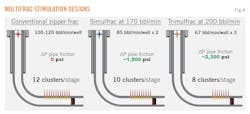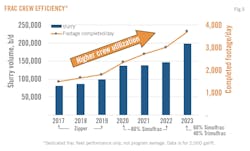Jordan Jackson
Ovintiv Inc.
Denver, Colo.
Trimulfracs are an extension of simultaneous fracturing treatments (simulfracs) to maximize capital efficiency. Trimulfracs keep pace with four to five drilling rigs and create greater consistency in job execution and enhanced safety and environmental performance.
Ovintiv’s Permian trimulfrac fleet completes more than 4,000 ft/d on average despite having higher stage-counts per well compared with simulfrac or zipperfrac treatments. Average capital cost savings are about $125,000/well compared with simulfrac wells and about $525,000/well compared with zipperfrac wells, assuming equivalent lateral well length.
No degradation has been observed in productivity since implementing Trimulfracs in the Permian basin. Specific trimulfrac pump schedules maintain high cluster efficiency, resulting in consistent rock stimulation.
Trimulfracs
Multifracturing treatments split operations among wells to minimize downtime in stimulation operations. Previous studies on simulfracs, treating two wells simultaneously, compared with zipperfracs showed that simulfracs were faster (typically 30%) and cheaper (typically 3-6%), but only with comparable treating rates per well.
Trimulfracs extend multifracturing to three simultaneous well completions. Ovintiv developed the process to maximize capital efficiency and keep pace with multiple drilling rigs. Trimulfrac pumping improves simulfrac hydraulic horsepower (HHP) utilization on location by reducing friction-induced treating pressure. This improvement increases overall pad pump rate and reduces cycle time, maintenance, and wear and tear on equipment.
Trimulfrac lowers pump rates on each well, reducing fracture-treating pressure, fuel usage, and friction reducer (FR) usage. Shortening (scaling down) stage length to reduce clusters per stage maintains fracture effectiveness while pumping at the lower rates. Trimulfrac stages are designed to maintain similar perforation friction, volume per cluster, rate per cluster, and rate per hole to a conventional zipper fracturing stage. This design ensures that rock stimulation is identical to zipper fracturing, resulting in equivalent stimulated rock volume (SRV).
Trimulfrac’s advantages include:
- Producing a consistent stimulated rock volume (SRV) by maintaining high cluster efficiency through effective hydraulics.
- Reducing daily and surface rental costs through faster cycle times.
- Lowering treating pressures through lowered pump rates per well, reduced FR usage, fuel consumption, emissions, and wear-and-tear on equipment.
- Reducing emissions by 20-30% metric tons CO2 equivalent (MTCO2e) compared with a diesel-powered zipperfrac fleet.
Trimulfrac execution
Fracture pumps are split into three isolated banks (Fig. 1). The banks simultaneously treat three different wells independently, at different treating pressures, while not adversely affecting SRV.
One blender pumps sand and water (slurry). The slurry splits evenly and meters individually to each bank of pumps. Additional clean fluid is pumped and individually metered to each bank of fracture pumps. Subsequently, the combined fluid from each bank of fracturing pumps is pumped into its own individual high-pressure manifold and directed down one wellbore, always in isolation from the other wellbores.
The data van individually controls and monitors each fracture pump bank. Wells can be treated independently with different levels of FR or other chemicals during fracturing if desired.
Ensuring the same rate of pumping for each bank of frac pumps provides equal sand and fluid distribution per well.
Trimulfrac follows the same methodology as simulfrac but requires additional equipment including frac pumps, high-pressure manifold, clean boost pump, flow meters, etc. (Fig. 2).
A trimulfrac crew may also require one to two extra equipment operators per shift versus a simulfrac crew. Only two wireline units are required, however, which is the same as in a simulfrac operation.
Downhole stage design
Maintaining high cluster efficiency (a measure of effectiveness in stimulating all clusters uniformly) is critical, regardless of fracturing method. Ovintiv achieves high trimulfrac cluster efficiency by managing hydraulics and perforation design.
Several diagnostic tools measure effective cluster efficiency, including tracer, fiberoptics, and downhole cameras-ultra sonic (Fig. 3).
Perforation imaging indirectly estimates treatment uniformity across clusters by measuring perforation-hole erosion. Uneven erosion patterns indicate that some clusters have taken more proppant than others, resulting in an uneven fracture treatment. Likewise, tracers in the fracture treatment reveal areas which have preferentially received fracture fluids.
As total pump rate drops in an individual well, stimulation design changes account for the loss of energy and its effect on rock stimulation. To maintain fracturing effectiveness with lower rates per well, clusters are removed, and stage length is scaled down compared with zipperfrac and simulfrac treatments. Trimulfrac stage design maintains the same perforation friction, volume per cluster, rate per cluster, and rate per hole as a conventional zipper fracture stage. These alterations ensure that the rock stimulates identically, which yields an equivalent SRV (Fig. 4). From a downhole perspective, zipperfrac, simulfrac, or trimulfrac produce identical energy and volume/ft.
For example, a fracturing treatment design which pumps 2,000 gal/ft or about 48 bbl/ft through 20-ft cluster-spacing (CS) requires the designs shown in the table maintain 960 bbl/cluster regardless of pumping method. All clusters have identical numbers of perforations, therefore volume through perforations is also identical regardless of pumping method. No additional stress shadowing occurs on a stage-to-stage basis.
Trimulfrac time, cost analysis
The designed job size for a well does not change regardless of which method completes the well. Proppant and fluid volumes remain identical, but the pumping rate increases significantly for trimufracs. Faster pumping results in quicker online development, reducing surface rental cost and overall capital costs. This efficiency also enables the frac crew to complete more wells in a calendar year, resulting in higher fleet utilization and fewer spot fleets.
On average, Ovintiv’s Permian trimulfrac fleet completes more than 4,000 ft/d and has exceeded 6,000 ft completed in 24 hr, even with higher stage counts per well. Overall pad efficiencies with one trimulfrac fleet keep pace with four to five drilling rigs.
This efficiency, paired with savings from lower fuel consumption and less FR usage, have resulted in total savings of about $125,000/well versus simulfrac and about $525,000/well compared with a traditional zipper frac (assuming equivalent lateral length, Fig. 5).
Trimulfrac’s higher total pump rates and daily volumetric fluid requirements require local water infrastructure and reliable water supplies. These operations also require on-pad sand storage and transportation. Ovintiv trialed wet sand in 2019 and began using it across about 70% of its Permian operations in 2020 (OGJ, Jul. 5, 2021, pp. 42-47). The sand pile system increased Ovintiv’s sand pumping from an average of 5 million lb/day (6 million lb/day peak) with zipper fracturing designs in 2019 to an average of 13 million lb/day (20 million lb/day peak) with current trimulfrac designs (Fig. 6).
Risk, productivity
Trimulfrac did not put the safety or execution of Ovintiv’s operations, well treatments, or job placements at risk. There are no concerns about treating adjacent zones or wells at the same time. Ovintiv has completed wells in the same zone adjacent to one another and has seen a negligible increase in ISIP and fracture gradients. Competing fracturing interactions have not prevented the company from executing stimulation treatments. Well pairs stimulated with the same intensity (proppant-fluid) per foot and per cluster have similar hydraulics which create similar fracture geometries and stimulated reservoir volumes (SRVs). Any offset fracture interference (OFI) would be similar to wells completed with zipperfrac.
Trimulfrac produces faster pad completions than a standard zipper or simulfrac, resulting in reduced OFI duration. Trimulfrac’s shorter stages also reduce exposure to compromised lateral lengths due to geologic hazards such as faults or a plug slip.
No degradation has been observed in productivity since implementing trimulfracs in the Permian. High cluster efficiency is maintained through hydraulics, resulting in consistent rock stimulation.
The Author
Jordan Jackson ([email protected]) is manager of completions for Ovintiv Inc., Denver, Colo. He holds a BS (2009) in petroleum engineering from Montana Technological University. He is a member of the Society of Petroleum Engineers.







